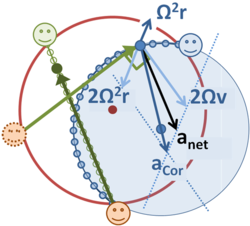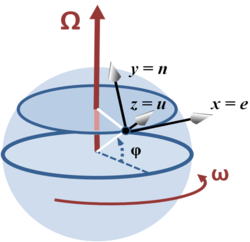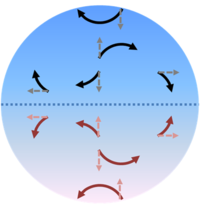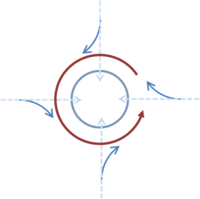Coriolis force
For the psychophysical perception, see Coriolis effect.
The Coriolis force is experienced by an object traversing a path in a rotating framework, a force that is proportional to its speed, to the speed of rotation, and also to the sine of the angle between its direction of movement and the axis of rotation. In vector notation, using the right-hand rule to associate a vector Ω with the rotation, the Coriolis force is FCor = 2m v × Ω, where × denotes the vector cross product, v is the body velocity and m is its mass. For a counterclockwise rotation of the observer's frame of reference, the Coriolis force is a push to the right when facing in the direction of the velocity. It is one of three such inertial forces that appear in an accelerating frame of reference due to the acceleration of the frame, the other two being the centrifugal force and the Euler force. The mathematical expression for the Coriolis force appeared in an 1835 paper by a French scientist Gaspard-Gustave Coriolis in connection with the theory of water wheels, and also in the tidal equations of Pierre-Simon Laplace in 1778.
Although sometimes referred to as an apparent force, it can have very real effects, among them the counterclockwise movement of winds around a low pressure area in the northern hemisphere (clockwise in the southern hemisphere).
Reference frames
Newton's laws of motion are expressed for observations made in an inertial frame of reference, that is, in any frame of reference that is in straight-line motion at constant speed relative to the "fixed stars", an historical reference taken today to refer to the entire universe. However, everyday experience does not take place in such a reference frame. For example, we live upon planet Earth, which rotates about its axis (an accelerated motion), orbits the Sun (another accelerated motion), and moves with the Milky Way (still another accelerated motion).
The question then arises as to how to connect experiences in accelerating frames with Newton's laws that are not formulated for such situations. The answer lies in the introduction of inertial forces, which are forces observed in the accelerating reference frame, due to its motion, but are not forces recognized in an inertial frame. These inertial forces are included in Newton's laws of motion, and with their inclusion Newton's laws work just as they would in an inertial frame. The introduction of inertial forces may sound like an accounting trick used for mathematical convenience, but the appearance of these inertial forces in Newton's laws has the very real meaning that these forces are experienced in the rotating frames just as certainly as forces arising from sources like masses, charges, or atomic nuclei.
The Coriolis force affects the aiming of artillery pieces and plotting transoceanic air flights, for example. A few examples below illustrate how Coriolis forces work.
Carousel
See also the discussion at Crossing a carousel.
The rotating carousel is perhaps the most common example used to illustrate the effects of rotation upon the formulation of Newton's laws of motion and the introduction of inertial forces into these laws. A simple case is playing catch on the carousel. Standing on the rim of the carousel, a ball is tossed to another player standing at a different position on the rim.
As shown in the figure, from the viewpoint of a stationary observer, the tossed ball is a free body (apart from downward gravity) so its horizontal motion is that of a free body: a straight line at constant speed. The catcher of the ball rotates during the flight of the ball, so the tosser (orange smiley face) must anticipate just where the catcher will be and tosses the ball toward that future position (green smiley face), rather than directly at the catcher.
From the viewpoint of an observer at the center of the carousel but rotating with it, both the person tossing the ball (orange smiley face) and the catcher (blue smiley face) are standing at fixed locations, as all three participants turn along with the carousel. However, the tosser cannot toss the ball directly toward the catcher, because the ball veers off to the right, assuming the carousel in counter-clockwise rotation. To the rotating observer, the curved path means that Newton's laws require a force to cause the ball to curve. The intuitive reaction is that the ball is pushed to the right during flight (by the Coriolis force), and so this force must be countered by throwing the ball somewhat to the left.
For both the rotating and the fixed observer, the distance of the ball from the center of the carousel at any moment in time is exactly the same. For example, the arrows in the figure show that the same distance is seen at the moment of closest approach of the ball to the center, which happens at the same time for both observers.
The center figure illustrates that to the rotating observer the ball executes an approximately circular motion about its center of curvature. The center of curvature of the path is displaced from the center of the carousel by a greater amount the slower the rate of rotation, and the radius of curvature increases. The Coriolis force (causing the rightward deflection of the ball) diminishes. As the rate of rotation slows to zero, the centripetal force drops to zero as the center of curvature recedes to infinity, the radius of curvature becomes infinite, and the path becomes a simple straight-line toss directly toward the catcher.
The lower figure shows more complex paths are possible. Here the ball is thrown from 6 o'clock and caught at 12 o'clock in all cases, but the carousel turns faster and faster, forcing the catcher to start from a greater and greater angle from 12 o'clock in order to arrive in time for the catch. Four cases are shown, where the catcher starts 1/4 turn, then 1/3 turn, 1/2 turn and 3/4 turn from 12 o'clock. The path in the stationary frame always is the same, but the path seen by the rotating observer becomes quite complicated.
From the spacing of the points marked on the figures, it may be seen that the ball moves more rapidly for the rotating observer. That can be understood as an increased speed because the carousel is rotating, moving toward the ball. To put it differently, a curved path is longer than the straight one seen by the inertial observer, so the ball has to move faster to cover the curved path in the same time.
A more detailed discussion follows.
Inertial frame
In the stationary frame, the path of the ball is given in x,y coordinates as:
where R is the radius of the carousel, θ is the angle of launch of the ball, v is the speed of launch, and t is the time. At t=0, the tosser is at 6 o'clock, as viewed in the figure, and θ is the angle from the horizontal to the line of throw. The catcher at this time is an angle φ from 3 o'clock. If the carousel turns at the rate Ω, then the catcher has turned from the starting position by an angle Ωtc, placing the catcher in position provided:
where tc is the time of the catch and φ is the starting angle of the catcher. This equation results from the lower diagram and the equality of corresponding angles of parallel lines:
The ball arrives at the rim for the arriving catcher when the path length equals the chord of the circle:
These two equations either determine the angle of launch in terms of a known speed by use of a nonlinear equation or, by assuming a time of catch, the first equation determines the angle of launch and the last equation determines the necessary speed of throw:
Rotating frame

The inertial accelerations on the ball combine to provide the net inward acceleration necessary for the curved path seen on the carousel. The two components of the Coriolis acceleration are shown, one radially inward toward the center of rotation and one acting to the right of the path. Notation v refers to the speed of the straight-line motion seen in the stationary frame.
The description in the rotating frame is more complex than in the inertial frame. The figure shows the calculated inertial forces upon the ball at a particular moment. The motion is nearly circular about a displaced center, but the speed of travel around the circular path varies. Consequently, the motion is only approximately uniform motion in a circular path, and the net acceleration (the sum of the two inertial accelerations, the outward centrifugal Ω2r and the Coriolis) is only approximately directed toward the center of the circle.
Below are the mathematical details.
Mathematical background
Variables in the inertial (non-rotating) frame of reference are identified by subscript A, and those for the rotating frame of the carousel by subscript B.
The trajectory in the inertial frame (denoted A) is a straight line path from 6 o'clock at angle θ. The position of the ball in the stationary frame at time t is:
with iA, jA the unit vectors in the x- and y-directions in the non-rotating frame, and assuming the ball is tossed from a 6 o'clock position at time t = 0. The speed v of the ball refers to the straight-line path seen in the stationary frame.
In the turntable frame (denoted B), the x- y axes rotate at angular rate Ω , and in terms of the unit vectors iB, jB taken to be stationary on the carousel,
which, substituted for the unit vectors, lead to the trajectory seen on the carousel as (components are in the iB, jB directions):
Introducing α as:
the velocity becomes:
If this motion were exactly uniform circular motion, the speed would be constant. Instead, the speed is given by:
To determine the components of acceleration, a general expression is used from the article inertial forces:
in which the term in Ω × vB is the Coriolis acceleration and the term in −Ω × ( Ω × rB) is the centrifugal acceleration. The results are (let α = θ − Ω t):
producing a centrifugal acceleration:
Proceeding with the calculation of the Coriolis force:
producing a Coriolis acceleration:
It is seen that the last term in the Coriolis acceleration not only cancels the centrifugal acceleration, but together they provide a net "centripetal" component of acceleration, radially inward (that is, directed toward the center of rotation):[1]
The other component of Coriolis acceleration given by:
is perpendicular to rB (t) + R (t) with the vector R (t) = R (sinΩt, cosΩt):
If the tosser stands on the ground instead of upon the carousel, the original point of toss is at 6 o'clock. This position appears to rotate clockwise in the rotating frame and is connected by R (t) to the axis of rotation (dotted smiley face). The vector rB (t) + R (t) locates the ball from the tosser. The distance from the tosser to the ball at any particular time is the same in both frames, and is independent of the rate of rotation, as shown in the figure by the green arrows emanating from the tosser:
The "centripetal" component of acceleration seen in the rotating frame resembles that for circular motion at radius rB, while the perpendicular component is velocity dependent, increasing with the speed v and directed to the right of the velocity. The situation could be described as a circular motion about the center of rotation combined with a sideways "Coriolis acceleration" of 2Ω v. However, this is a rough labeling: a careful designation of the true centripetal force refers to a local reference frame that employs the directions normal and tangential to the path, not coordinates referred to the axis of rotation.
These results also can be obtained directly by two time differentiations of rB (t).
Observations
As a result of this analysis an important point appears: all the inertial forces must be included to obtain the correct trajectory. In particular, besides the Coriolis force, the centrifugal force plays an essential role. It is easy to get the impression from verbal discussions of the ball problem, which are focused on displaying the Coriolis force particularly, that the Coriolis force is the only factor that must be considered;[2] emphatically, that is not so.[3] A turntable for which the Coriolis force is the only factor is the parabolic turntable, a concave turntable shaped to provide the centrifugal force of a curved path through its curvature in the manner of a banked turn.
A somewhat more complex situation is the idealized example of flight routes over long distances, where the centrifugal force of the path and aeronautical lift are countered by gravitational attraction.[4][5]
Rotating sphere
See also the discussion at Foucault pendulum.
This example considers the Coriolis force seen by observers on the surface of a rotating sphere. This analysis underlies many observations in meteorology (discussed next) and is useful in understanding how Foucault's pendulum can be used to determine the rate of rotation of the Earth. .
Consider a location with latitude φ on a sphere that is rotating around the north-south axis. A local coordinate system is set up with the x-axis horizontally due east, the y-axis horizontally due north and the z-axis vertically upwards. This coordinate system sometimes is called the tangent-plane coordinate system.[6] The rotation vector, velocity of movement and Coriolis acceleration expressed in this local coordinate system (listing components in the order East (e), North (n) and Upward (u)) are:
When considering atmospheric or oceanic dynamics, the vertical velocity is small and the vertical component of the Coriolis acceleration is small compared to gravity. For such cases, only the horizontal (East and North) components matter. The restriction of the above to the horizontal plane is (setting vu=0):
where f = 2ω sinφ is called the Coriolis parameter.[7]
By setting vn = 0, it can be seen immediately that (for positive φ and ω) a movement due east results in an acceleration due south. Similarly, setting ve = 0, it is seen that a movement due north results in an acceleration due east. In general, observed horizontally, looking along the direction of the movement causing the acceleration, the acceleration always is turned 90° to the right and of the same size regardless of the horizontal orientation. That is:[8][9]
| ‘ | On a merry-go-round in the night Coriolis was shaken with fright |
’ |
—David Morin, Eric Zaslow, E'beth Haley, John Golden, and Nathan Salwen | ||
As a different case, consider equatorial motion setting φ = 0°. In this case, Ω is parallel to the North or n-axis, and:
Accordingly, an eastward motion (that is, in the same direction as the rotation of the sphere) provides an upward acceleration known as the Eötvös effect,[10] and an upward motion produces an acceleration due west.
Meteorology
A pressure gradient in the atmosphere is equalized by driving a wind along the pressure gradient. However, from the viewpoint of meteorology, the motion is observed most naturally within the reference frame of a rotating Earth. As pointed out just above and in the figure to the left, in the Earth's reference frame any motion is affected by a Coriolis force, as given by:
where f = 2ω sinφ is the Coriolis parameter. Consequently, the wind takes an apparent direction deflected to the right of the pressure gradient in the northern latitudes, and to the left in the southern latitudes. The Coriolis parameter is a maximum at the poles, zero at the equator and flips sign as one crosses from the northern to southern hemispheres, as indicated in the figure.
One consequence is that a low pressure region that sucks air into it, as shown in the figure on the right, results in a counterclockwise flow of winds in the northern hemisphere (called a cyclone) because of the Coriolis force.[11] The direction is opposite in the southern hemisphere.
It is sometimes suggested that the draining of a bathtub is another example of cyclone motion, but it appears that in this example there are conflicting forces (introduced by the shape of tub near the drain, and the initial conditions of flow) that can overpower the Coriolis force and dictate the direction the vortex spins.[12]
Notes
- ↑ Here the description "radially inward" means "toward the axis of rotation". That direction is not toward the center of curvature of the path, however, which is the direction of the true centripetal force. Hence, the quotation marks on "centripetal".
- ↑ George E. Owen (2003). Fundamentals of Scientific Mathematics, original edition published by Harper & Row, New York, 1964. Courier Dover Publications, p. 23. ISBN 0486428087.
- ↑ Morton Tavel (2002). Contemporary Physics and the Limits of Knowledge. Rutgers University Press, p. 88. ISBN 0813530776.
- ↑ James R Ogden & M Fogiel (1995). High School Earth Science Tutor. Research & Education Assoc., p. 167. ISBN 0878919759.
- ↑ James Greig McCully (2006). Beyond the moon: A Conversational, Common Sense Guide to Understanding the Tides. World Scientific, pp. 74–76. ISBN 9812566430.
- ↑ See Dominic Reeve, Andrew Chadwick, Christopher Fleming (2004). “Figure 4.11”, Coastal engineering: processes, theory and design practice. Taylor & Francis, p. 116. ISBN 0415268419. and A Chandrasekar (2010). “§6.5.3: f-plane and β-plane approximations”, Basics Of Atmospheric Science. PHI Learning Private Ltd., pp. 168 ff. ISBN 8120340221.
- ↑ For a discussion of the role of the Coriolis parameter in ocean dynamics see John Norbury (2002). “§6.3 Further geometric and Coriolis approximations”, Large-scale Atmosphere-ocean Dynamics: Analytical methods and numerical models. Cambridge University Press, pp. 35 ff. ISBN 052180681X.
- ↑ David Morin, Eric Zaslow, Elizabeth Haley, John Goldne, and Natan Salwen (2 December 2005). Limerick – May the Force Be With You. Weekly Newsletter Volume 22, No 47 (at the end of this issue). Department of Physics and Astronomy, University of Canterbury. Retrieved on 2009-01-01.
- ↑ David Morin (2008). Introduction to classical mechanics: with problems and solutions. Cambridge University Press, p. 466. ISBN 0521876222.
- ↑ The Eötvös effect must be corrected for in determining the effects of gravity aboard ship. See Manik Talwani (1906). “Gravity measurements aboard surface ships: Eötvös effect”, Hyman Orlin, ed.: Gravity anomalies: unsurveyed areas. American Geophysical Union, p. 46.
- ↑ For further discussion see James T. Shipman, Jerry D. Wilson, Aaron Todd (2007). An Introduction to Physical Science, 12th ed. Cengage Learning, pp. 557 ff. ISBN 0618935967.
- ↑ Christopher Jargodzki, Franklin Potter (2001). “§350: The bathtub vortex”, Mad about Physics: Braintwisters, Paradoxes, and Curiosities. John Wiley and Sons, p. 277. ISBN 0471569615.







































